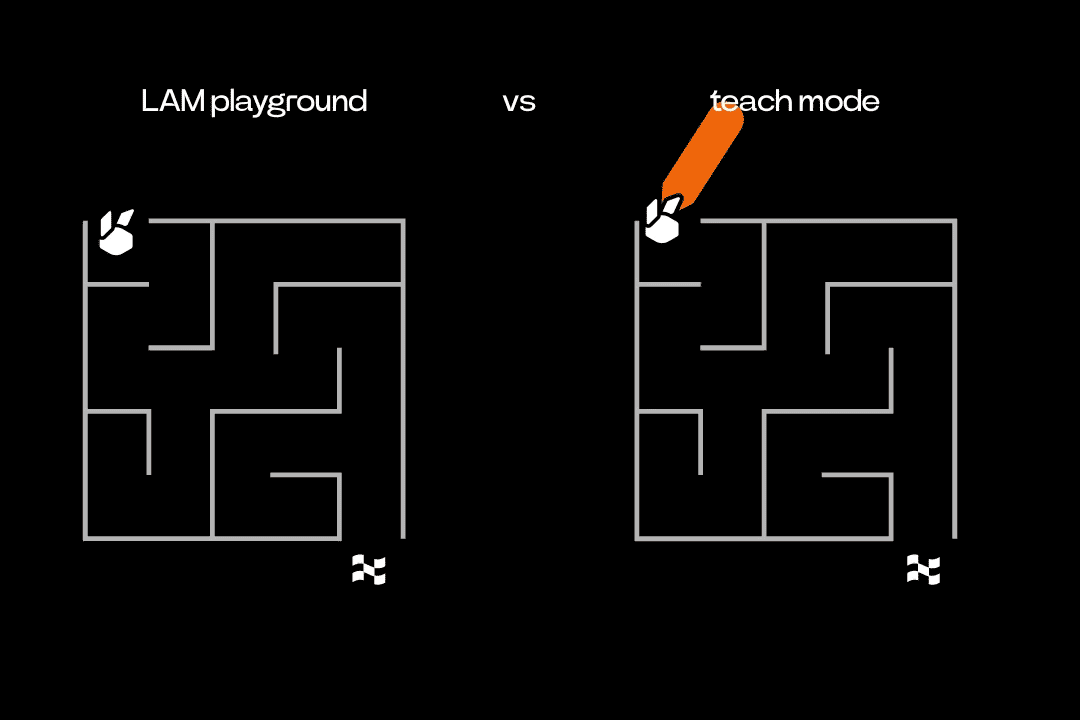If you want to build an AI agent, there are many different ways to do it. And there are different ideas circulating in the AI community about which technical approach will ultimately yield the most robust general agent.
At rabbit, we develop experiments to explore a variety of technical approaches. Teach mode represents our efforts to bring one of these experiments to users right now.
In September, we made teach mode available to a small group of users in a closed alpha program. We were surprised and delighted by the results! Teach mode alpha testers used their personal agents to successfully perform tasks across a variety of websites — including X, Spotify, YouTube, and Discord.
Together, our alpha group has made hundreds of lessons and has given us huge amounts of valuable feedback to improve the experience. We know that bringing in even more users will help us to accelerate even faster, so we have opened up teach mode beta to all r1 users. You can register your interest by entering your email address below, and stay tuned for more information as we get closer to launching the beta program later this year.
try it on rabbithole now
you need an active rabbithole account and an r1 to try teach mode.
our thinking behind teach mode
Technology-wise, the “big idea” behind teach mode is that AI agents may work best by learning from your examples. In other words, teach mode learns to perform tasks by first studying how you perform tasks. If you try it, you’ll see what we mean: You can teach the agent how to perform a task on the web — and then later you can ask the agent to recall the lesson and perform that task for you. The agent is also smart enough to intuit subtle variations of your lessons — so it can swap certain details, automatically “filling in the blanks” to perform similar but slightly different tasks.
teach mode vs. LAM playground
By comparison, LAM playground is an AI agent that’s based on a technical approach which interprets the world quite differently. LAM playground doesn’t learn by your example — but rather, it attempts to navigate websites “on the fly,” without any prior preparation.
The main difference between teach mode and LAM playground is simply some tradeoffs. An AI agent which requires no teaching — like LAM playground — can feel more intuitive and fun for users. After all, there’s no need to provide a lesson example first — you can simply command it to obey your wishes! But since this kind of agent tries to navigate the world without a map, it can be more prone to errors which slow things down and require backtracking. By contrast, a teachable agent — like the one which powers teach mode — brings a more rigorous and structured understanding of the task to be performed. This can potentially result in better success rates which compound over time to create a more robust agent, as the agent accumulates knowledge of the lessons it’s been taught.

The teach mode agent is designed to study and replay each of the individual steps you take to perform a task on the web. It learns each button and input box you click to search, to add items to your shopping cart, and so on. So if you think of an AI agent as a personal assistant who interprets your instructions, the teach mode agent is an assistant who’s a bit more “detail oriented” than LAM playground. That means the teach mode agent makes it easier and more satisfying for you to express complex, finely detailed tasks. By comparison, LAM playground attempts to intuit the details from the overall gist of what you want accomplished, but in doing so it can make some mistakes along the way.
Agentic AI is a rapidly evolving field. On the path to a robust and general cross-platform agent, there are sure to be some surprises along the way. Teach mode represents an approach that we believe has real potential to advance the state of the art. We can’t wait to see what you do with it!
see how teach mode works
@dotJustin, one of our first testers of teach mode, is here to walk you through the ins and outs of teach mode. he will show you how teach mode works, and then go through some useful examples including how to teach your rabbit to retrieve information, summarize information, draft a tweet and star a GitHub repo.
this is the start of your teach mode experiment with us. check out Justin’s full video on his channel @dotJustin and join the discussion with other testers and users in our forum. the more you play with teach mode and share your feedback with us, the faster the teach mode experience will improve. hop around and find out!